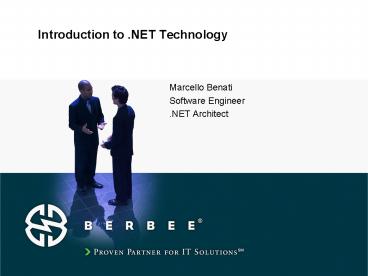Introduction to .NET Technology - PowerPoint PPT Presentation
1 / 20
Title:
Introduction to .NET Technology
Description:
... development, mobile development are all programmed in the same type of fashion ... Interoperation Active Directory. Active Directory is right at home in .NET ... – PowerPoint PPT presentation
Number of Views:1023
Avg rating:3.0/5.0
Title: Introduction to .NET Technology
1
Introduction to .NET Technology
- Marcello Benati
- Software Engineer
- .NET Architect
2
Agenda
- Introductions
- NET Architecture concepts and how they interact
with W3C Standards - Microsoft Business Integration Roadmap (2006
onward) - Brief explanation of BizTalk Server, SharePoint
Portal and Host Integration Server - Some examples of how we integrated Microsoft to
ISeries and AS/400 (high level) - Best Practices of the .NET SOA
3
What Is .NET?
- Foundation of development efforts from here on
out - Unified development, regardless of language
- Common functionality available via a class
library language independent - Integrated Development Environment that behaves
similarly for all languages - Unified development, regardless of platform
- Class library, templates, etc. allow development
on many platforms - Web development, desktop development, mobile
development are all programmed in the same type
of fashion
4
What Is .NET? (cont)
- Unified development, regardless ofoperating
system? - In theory, quite possible - .NET applications
could be run on other operating systems! Just
need the key .NET elements ported to the platform - Such efforts already exist Mono (.NET apps on
nix), Rotor (open source .NET CLI) - Microsoft is supporting and even sponsoring many
of these initiatives
5
.NET Core Technology
- .NET has quite a few different parts
- Common Language Runtime (CLR)
- Common Language Infrastructure (CLI)
- Common Language Specification (CLS)
- .NET Framework tools (examples include gacutil,
sn, and all the compilers) - .NET Framework is FREE (including the compilers!)
- .NET development is made MUCH easier by using
Visual Studio .NET
6
How .NET Impacts Businesses
- Productivity Increases
- Reduced development time (class library, more
efficient coding constructs) - example - Keep existing language skills intact
- Allows more interoperation between developers
- Better Code
- Means less support and help desk calls!
- Again, accomplished in large part by the class
library - Also due to better coding constructs and patterns
- Faster Code
- Fewer lines of code
- Better memory management
- JIT compiling
7
Technical Advancements
- The Class Library! (CLR)
- No longer need languages like C to get
difficult tasks accomplished - Dont have to rely on the Win32 API (though you
still can) - Continuing evolution
- New Languages
- C (C-Sharp)
- The power of C, the ease of Java
- Ideal candidate for new development
- Visual Basic .NET
- Not just a new version of Visual Basic
- Brings new functionality to the platform has
almost all the power of any other .NET language,
including C - Very easy to pickup by current VB developers
8
Technical Advancements (cont)
- Interoperability
- You dont need to get rid of existing code!
- Upgrade it
- Connect to it
- You can use .NET from legacy applications
- Expose .NET components as COM (ActiveX) objects
- Transparent calling
- Interoperate with other platforms
- Connect with Java
- Connect with objects on other platforms
Unix/Linux, mainframes
9
Interoperation Active Directory
- Active Directory is right at home in .NET
- There is a set of objects in the class library
specifically for interacting with Active
Directory/LDAP sources System.DirectoryServices
namespace - Can query AD objects, as well as update and
delete them - MUCH easier than ADSI calls binding operations
can be done in a single line, and individual
properties can then be queried - Using other class library objects, can test for
user/group membership - Makes developing secure authenticating
applications much easier
10
(No Transcript)
11
(No Transcript)
12
Microsoft Integrated Platform
13
Interoperability - Databases
- Data is all-important to the .NET strategy
- Built in managed providers for SQL Server, and
now for Oracle - Managed providers are much faster than their ODBC
counterparts - Can be easier to use as well
- Other databases are not left out Access, DB2,
MySQL, etc. can be handled through the OLEDB
provider - Non-traditional databases like Excel can also
be accessed easily
14
(No Transcript)
15
Advancements in Web Applications
- Web Services
- A very big selling point for .NET - .NET was
built with web services in mind! - Very easy to build web services usually
involves adding one line of code to an object - Even easier to consume web services, including
those running on Java platforms - ASP.NET
- Forget everything you knew about ASP
- ASP.NET applications can be built in any .NET
language - They are compiled very high performance
- Useful tools built into Visual Studio
- WYSIWYG interface for design
- Drag and drop components on to forms
- Validation, authentication and other objects are
easily leveraged
16
Deployment considerations
17
(No Transcript)
18
.NETs Future (cont)
- Windows VISTA
- A whole new set of programming interfaces
bye-bye Win32! - New advancements in technology
- Avalon, a whole new graphics interface
- WinFS, a new file system architecture
- Indigo, unified messaging
- This will all have its foundations in .NET
19
Questions?
20
Thank You!































